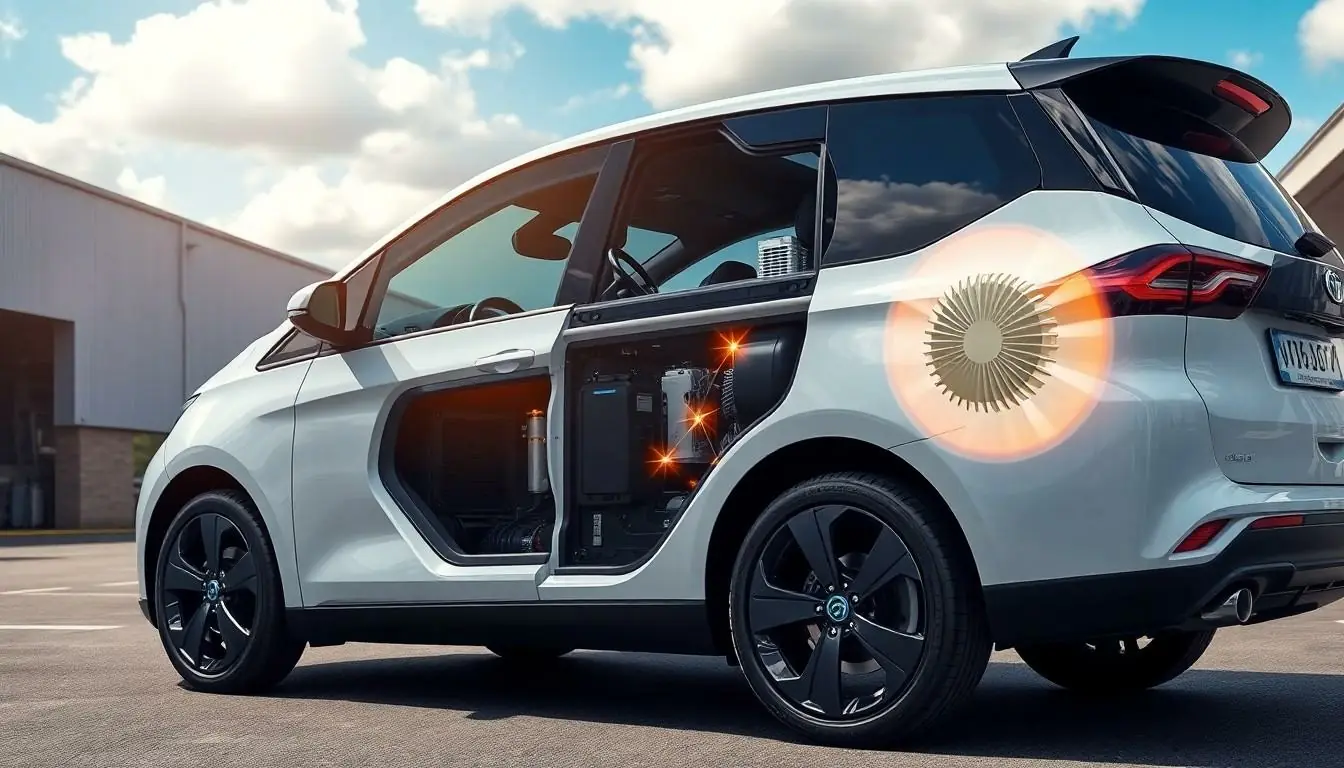Electric vehicles are the future, but they can’t run hot and bothered. Just like a well-timed coffee break, thermal management plays a crucial role in keeping EVs cool under pressure. With the rise of electric cars, understanding how to manage heat isn’t just a nice-to-have; it’s a must-have for performance, efficiency, and longevity.
Imagine cruising down the highway, your EV purring like a kitten, while its battery is kept cooler than a polar bear in a snowstorm. Smart thermal management systems ensure that the vehicle operates at optimal temperatures, preventing overheating and maximizing range. So buckle up as we dive into the fascinating world of thermal management in electric vehicles, where science meets the road, and staying cool is the name of the game.
Table of Contents
ToggleOverview of Thermal Management in Electric Vehicles
Effective thermal management plays a crucial role in the performance and efficiency of electric vehicles (EVs). Managing heat involves keeping battery systems within optimal temperature ranges to enhance energy output and extend battery life. Cooling and heating systems regulate temperatures using advanced technologies, ensuring safety and performance remain intact.
Active cooling methods often utilize liquids or air to remove excess heat from batteries. Cooling plates and heat exchangers play significant roles in these systems, maintaining stability under various driving conditions. Another critical aspect involves insulation techniques that reduce heat losses, allowing the vehicle to conserve energy.
Thermal management also impacts the overall driving range. By maintaining battery temperatures, EVs not only perform better but also exhibit improved longevity, contributing to cost-effectiveness over time. Proper heat management contributes to faster charging times while reducing stress on the battery components.
Understanding and improving thermal control systems remains vital. Sensors monitor conditions in real-time, enabling proactive adjustments to the thermal management strategy. As EV technology evolves, manufacturers integrate these systems to adapt to higher power demands and greater efficiency standards.
Innovations in thermal management will shape the future of electric vehicles. Advanced materials and design approaches enhance heat distribution and isolation, pushing the boundaries of current technologies. The emphasis on efficient thermal management underscores its potential to revolutionize the EV market, leading to a more sustainable transportation future.
Importance of Thermal Management

Effective thermal management significantly impacts electric vehicles. Maintaining optimal temperatures ensures performance, efficiency, and longevity.
Impact on Vehicle Performance
Vehicle performance relies heavily on heat management. Overheated components can lead to reduced power output and decreased efficiency. Active cooling systems, including liquid and air methods, work to prevent overheating, thus maintaining peak performance during operation. Cooling plates play a crucial role, distributing heat evenly while safeguarding against thermal stress. Consistent temperature regulation also enhances vehicle stability during varied driving conditions. Adopting smart thermal management technologies fosters faster acceleration and superior driving experiences.
Influence on Battery Life
Battery life receives substantial benefits from proper thermal management. Optimal temperature regulation enhances energy efficiency, which translates to longer battery lifespan. When batteries operate within ideal temperature ranges, they experience less wear and tear, leading to increased cycle life. Real-time monitoring enables adjustments that prevent overheating and excessive cooling, both detrimental to battery health. Furthermore, advanced materials and design approaches help mitigate heat losses, optimizing overall energy use. Investing in effective thermal management strategies contributes to cost savings by prolonging battery life and performance.
Key Components of Thermal Management Systems
Thermal management systems in electric vehicles rely on various components to maintain optimal temperatures. Two critical areas of focus are cooling systems and heating systems.
Cooling Systems
Cooling systems play a vital role in temperature regulation. Liquid cooling technologies facilitate heat transfer away from battery components, ensuring efficient thermal control. Air cooling systems also manage heat but are often less effective in high-performance scenarios. Heat exchangers enhance cooling efficacy by increasing surface area contact. Utilizing advanced thermal materials improves heat dissipation and reduces thermal resistance. Efficient cooling extends battery life and boosts overall vehicle performance, preventing overheating during intense driving conditions.
Heating Systems
Heating systems ensure comfortable cabin temperatures and maintain battery efficiency in cold weather. Resistance heaters often provide immediate warmth, but heat pumps can offer greater energy efficiency by extracting heat from the environment. Integrating waste heat recovery systems recycles energy generated during operation, thereby minimizing energy consumption. Batteries operate best within specific temperature ranges; therefore, maintaining ideal conditions through effective heating can enhance performance. Advanced insulation technologies further support efficient heating by reducing energy losses, ensuring effective performance regardless of external temperatures.
Technologies Used in Thermal Management
Thermal management in electric vehicles leverages diverse technologies to maintain optimal performance. Key components like liquid cooling solutions and phase change materials significantly enhance the efficiency of EV systems.
Liquid Cooling Solutions
Liquid cooling systems utilize coolant fluid to transfer heat away from critical components. These systems circulate coolant through channels or plates, maintaining safe operating temperatures for batteries and electronics. By efficiently removing heat, liquid cooling solutions reduce the risk of overheating and extend component life. They often include radiators and pumps to enhance heat exchange capabilities. Performance during extreme driving conditions benefits as well, thanks to the enhanced cooling capacity. Many manufacturers favor liquid cooling for its ability to support high-performance applications along with charging efficiency.
Phase Change Materials
Phase change materials (PCMs) offer innovative ways to manage heat by absorbing or releasing thermal energy during phase transitions. PCMs store excess heat when temperatures rise, then release it as temperatures drop, creating a buffer against temperature fluctuations. This technology prevents overheating in batteries and optimizes thermal efficiency during charging. PCMs are lightweight and compact, making them suitable for integration into various EV components. Their effectiveness in maintaining stable temperatures contributes to overall battery health, enabling longer cycle lives and improved performance under varying conditions.
Future Trends in Thermal Management
Innovations in thermal management are critical as electric vehicles evolve. Emerging technologies focus on enhancing the efficiency of cooling and heating systems. Integration of artificial intelligence might facilitate real-time thermal monitoring, allowing systems to adapt based on driving conditions. Advanced sensors enhance data accuracy for optimal temperature regulation.
Companies are exploring advanced materials for better thermal conductivity. Lightweight composites and nanomaterials show promise in minimizing heat losses. Deployment of phase change materials (PCMs) is gaining traction, providing efficient energy storage and temperature stabilization.
Expanded use of waste heat recovery systems could optimize energy efficiency further. These technologies capture excess heat generated during operation for reuse, benefiting overall energy performance. Additionally, hybrid cooling systems that combine liquid and air cooling methods are under development. Such systems promise improved thermal regulation under challenging conditions.
Collaboration between automakers and research institutions fosters innovation in thermal management solutions. Efforts focus on creating integrated systems that enhance battery longevity and performance while minimizing energy consumption. Regulatory trends push for stricter standards around emissions and energy efficiency, motivating advancements in thermal management technologies.
Market demand for sustainable transportation drives companies to invest in next-generation thermal management systems. Stakeholders prioritize the development of solutions that balance performance and environmental responsibility. As the sector progresses, consumer acceptance of electric vehicles will likely depend on the effectiveness of these thermal management innovations.
Thermal management is a cornerstone of electric vehicle technology. As the industry evolves the focus on effective heat regulation will only intensify. Innovations in cooling and heating systems are set to enhance performance while promoting energy efficiency.
The integration of advanced materials and smart monitoring solutions will play a pivotal role in optimizing battery life and driving range. With the growing demand for sustainable transportation the importance of efficient thermal management cannot be overstated.
As automakers and researchers collaborate on next-generation solutions the future of electric vehicles looks promising. Enhanced thermal management will not only improve vehicle performance but also contribute to a greener, more sustainable world.

